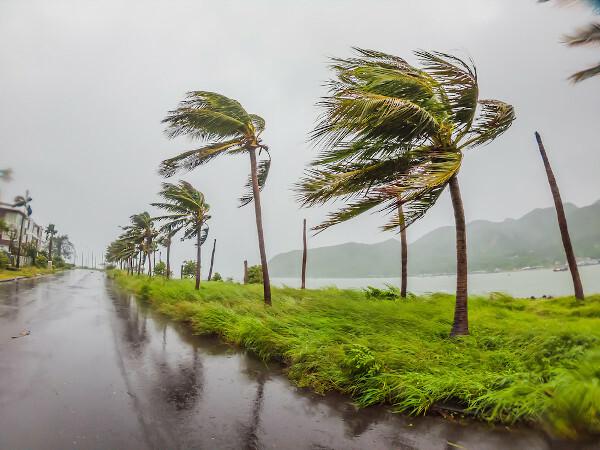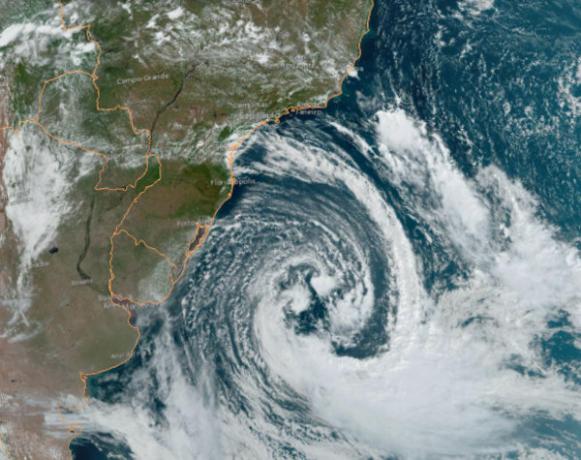extratropical cyclone is an atmospheric phenomenon characterized by low pressure systems that settle in the areas of medium and high latitudes of planet Earth in both hemispheres. These systems are caused by the temperature difference between cold air masses and warm air masses that, when moving in opposite directions, end up colliding. Therefore, we say that extratropical cyclones are directly linked to the advance of cold fronts.
Extratropical cyclones cause winds ranging from weak to intense, high cloud cover and rainfall. After its dissipation, cold weather sets in, with a drop in temperatures. The consequences of these cyclones depend on the intensity of their effects, which may cause floods, landslides, falls of trees, interruption of electricity supply, leaving people homeless and, in more serious cases, causing death.
Read too: What is the difference between hurricane, tornado and cyclone?
Topics of this article
- 1 - Summary on extratropical cyclone
- 2 - What is an extratropical cyclone?
- 3 - Causes of the extratropical cyclone
- 4 - How does the extratropical cyclone work?
- 5 - What are the differences between the extratropical cyclone and the tropical cyclone?
- 6 - Effects and consequences of the extratropical cyclone
- 7 - Extratropical cyclone in Brazil
- 8 - Extratropical cyclone in the world
Extratropical Cyclone Summary
It is a type of cyclone (tropical storm that originates in zones of low atmospheric pressure) that forms in the areas of medium and high latitudes of the planet Earth, therefore, outside the tropics.
Extratropical cyclones are atmospheric phenomena caused by the temperature contrast between a warm air mass and a cold (or polar) air mass.
They are characterized by low pressure systems that form from the meeting between these air masses contrasting temperatures. Therefore, it is said that extratropical cyclones are always associated with cold fronts.
They have as effects the occurrence of winds with variable intensity, high cloudiness and rains.
After its passage, the tendency is for a drop in temperatures due to the dominance of the cold air mass.
Depending on the intensity of their effects, they can cause flooding, landslides, falling trees, interruptions in the supply of electricity.
They are quite common near the southern coast of Brazil.
The most recent extratropical cyclone to hit Brazilian territory took place in June 2023 and caused very heavy rains, gusts of wind and large floods in Rio Grande do Sul and Santa Catherine.
Do not stop now... There's more after the publicity ;)
What is an extratropical cyclone?
extratropical cyclone is a type of cyclone what happens in the middle areass and tall latitudes from planet earth. It can be described as a low atmospheric pressure system that forms when a cold front meets a warm front.
This atmospheric phenomenon occurs predominantly in areas close to latitudes of 45º, but, as the name suggests, it is characteristic of locations located outside the tropical zone. Therefore, extratropical cyclones form between latitudes 30º and 60º in both hemispheres.

Causes of the extratropical cyclone
The extratropical cyclones are associated with the contrast of temperatures over an area. They are caused by the advance of a cold air mass, called a polar air mass, towards regions that are under the domain of a warm air mass. Low pressure systems are installed on the boundary between these different air masses, where the fronts are constituted. For this reason, it is common to read that the formation of an extratropical cyclone is linked tothe advancement of a cold front.
How does an extratropical cyclone work?
An extratropical cyclone forms when there is a temperature gradient caused by the approach of a polar air mass, which holds lower temperatures, from warm areas. Therefore, he can form both over oceans and over land.
These contrasting air masses are moving in opposite directions, and, at the boundary between them, waves (or frontal waves) are formed caused by the advance of one mass over the other. When it happens, the hot air, which has lower density, overlaps the cold air, and the continuity of this processresults in the rotary movement of air,|1| which originates the characteristic winds of this phenomenon.

The speed of these winds is variable, and can be compared to tropical depressions, which have speeds below 60 km/h, or hurricanes, which can exceed 118 km/h.|2| However, extratropical cyclones are larger in diameter than other types of cyclone (tropical and subtropical). It is also interesting to note that O period of formation of an extratropical cyclone can vary between 12 and 24 hours, and their effects tend to disappear in a comparatively shorter period of time.
Considering that the extratropical cyclone is formed in the cold fronts and works through the warm ascending winds that cause the displacement of the humidity, there is intense cloud cover and precipitation in the form of rain. In cases where the surface temperature exceeds 27ºC, thunderstorms may form, according to the National Weather Service of the United States. As the cold air manages to move in and take the place of the warm air, the effects of the extratropical cyclone gradually dissipate.
What are the differences between an extratropical cyclone and a tropical cyclone?
extratropical cyclone |
tropical cyclone |
Forms in mid- and high-latitude areas from planet earth. |
It forms in the tropical region of planet Earth, between the tropics of Cancer and Capricorn. |
It originates from the temperature contrast resulting from the meeting of a cold air mass and a warm air mass. |
It originates over warm tropical waters, where the air is also warm and humid. It is not associated with the approach of a cold front. |
It has less intense winds, but tends to have a larger diameter. |
It has more intense winds, but tends to have a smaller diameter. |
It has spiral-shaped clouds. |
It has rounded clouds. |
It is more common in Brazil, more precisely in the south region. |
It's rarer in Brazil. |
Effects and consequences of the extratropical cyclone
The extratropical cyclones have the effect of winds whose intensity varies of weakThe The intense, increased cloudiness and rainfall persistent, which can be very strong and voluminous depending on the location considered and the intensity of the phenomenon. After the passage of the cyclone, register temperature drop due to the complete replacement of the warm air mass by the polar mass.
The atmospheric effects caused by extratropical cyclones have consequences for the locations affected by them, and can cause serious damage to populations. Below is a list of some of these consequences:
Floods and overflows resulting from the large volumes of rain and the increase in the water level in the rivers.
Agitated sea water and high-magnitude waves, which can cause accidents on the high seas, such as shipwrecks, and reach coastal cities.
Falls from trees and electrical poles that can cause damage to the power grid and material damage, in the case of cars and houses affected, or even more serious accidents.
Slope landslides and floods.
Interruption in the supply of electricity.
Unroofing of houses and buildings, depending on the intensity of the winds.
Disappearance of people and animals.
Accidents that can cause injuries and even death.
Extratropical Cyclone in Brazil

The occurrence of extratropical cyclones is not uncommon in Brazil.. They form near the southern coast of the country, in the South Atlantic region, with greater frequency in the months corresponding to autumn and winter, when the frequency of approximation of polar air masses to the National territory.
The most recent extratropical cyclone that hit the country directly affected the coastal municipalities of the statessfrom Rio Grande do Sul It is from Santa Catarina just days away from the start of winter 2023. Some cities in Rio Grande do Sul recorded, in a few days, accumulated volumes of rain that would be expected for several months, reaching almost 400 mm of rain in certain locations. Wind gusts of over 100 km/h, thousands of people without electricity, floods and flooding were recorded in the state and also in Santa Catarina. In Rio Grande do Sul, by June 18th, 13 people had lost their lives and 4 were missing as a result of the cyclone.
In the year 2020, the same region recorded a type of extratropical cyclone known as a bomb cyclone.. According to MetSul Meteorologia,|3| this was one of the worst events related to atmospheric weather in southern Brazil, and affected the three states of the region for two days, between the end of june and the beginning of july. The installation of a low pressure system in the South Atlantic caused very strong gales, with winds of almost 200 km/h in some areas, storms and very heavy rains, which caused large floods. In addition to the trail of destruction, 13 people died.
Hurricane Catarina, which occurred in 2004, also originated from an extratropical cyclone. This hurricane devastated areas in the states of Santa Catarina and Rio Grande do Sul, leaving at least 25,000 people homeless, hundreds injured and 11 dead.
Also access: Tsunami in Brazil—a possibility or a legend?
Extratropical cyclone in the world
Extratropical cyclones are very common phenomena to be recorded in both hemispheres of planet Earth, affecting areas such as southern South America, North America, notably the United States and Canada, northern and western Europe, part of Asia and Oceania.
In 1993, the European continent was hit by one of the worst extratropical cyclones in the Hemisphere. Nonorth, which became known as the Braer Storm. The low pressure area settled on January 8th, and the cyclone dissipated only 11 days later, on January 17th, causing strong winds of up to 150 km/h and heavy rains in the United Kingdom and Iceland, also affecting territories such as Greenland, on the other side of the Atlantic North.
In the Southern Hemisphere, this phenomenon is more common in autumn. O extratropical cyclone that hit Uruguay in 2005 was one of the most violent on record. in this region of the planet. It started near the River Plate and entered Uruguayan territory with winds varying between 80 km/h and 187 km/h, and reached densely populated regions, as was the case in the capital, Montevideo. In all, more than 100,000 people were affected and 10 people lost their lives.
Grades
|1| REBOITA, M. S.; MARRAFON, V. H. Extratropical cyclones: what they are, climatology and impacts in Brazil.Terrae Didatica, Campinas, SP, v. 17, p. 1-13, 2021. Available in: https://periodicos.sbu.unicamp.br/ojs/index.php/td/article/view/8666028.
|2| ESSAY. What is an extratropical cyclone? Phenomenon is causing strong storms in southern Brazil. National Geographic, 2023. Available in: https://www.nationalgeographicbrasil.com/meio-ambiente/2023/06/o-que-e-um-ciclone-extratropical-fenomeno-esta-provocando-fortes-tempestades-no-sul-do-brasil.
|3| METSUL. Bomb cyclone swept southern Brazil a year ago. MetSul Meteorology, 2021. Available in: https://metsul.com/ciclone-bomba-varria-o-sul-do-brasil-ha-um-ano/.
Sources
G1 RS; RBSTV. Cyclone in RS: the number of dead reaches 13; Four people remain missing, says Civil Defense. G1, 2023. Available in: https://g1.globo.com/rs/rio-grande-do-sul/noticia/2023/06/18/ciclone-no-rs-numero-de-mortos-e-desaparecidos.ghtml.
GRANCHI, G. extratropical cyclone: what is the phenomenon that causes rain and wind in part of Brazil. BBC News Brazil, 2023. Available in: https://www.bbc.com/portuguese/articles/c80d52x27p1o.
METSUL. Cyclone effects persist during the week in Rio Grande do Sul. MetSul Meteorology, 2023. Available in: https://metsul.com/efeitos-do-ciclone-persistem-durante-a-semana-no-rio-grande-do-sul/.
NATIONAL WEATHER SERVICE. Tropical, subtropical, extratropical? National Weather Service, [n.d.]. Available in: https://www.weather.gov/source/zhu/ZHU_Training_Page/tropical_stuff/sub_extra_tropical/subtropical.htm.
PARRY, M. L. et al. (Ed.). climate change 2007: Working Group II: Impacts, Adaptation and Vulnerability. CambridgeUniversityPress, 2007. Available in: https://archive.ipcc.ch/publications_and_data/ar4/wg2/en/ch13s13-2-2.html.
REBOITA, M. S.; MARRAFON, V. H. Extratropical cyclones: what they are, climatology and impacts in Brazil. Terrae Didatica, Campinas, SP, v. 17, p. 1-13, 2021. Available in: https://periodicos.sbu.unicamp.br/ojs/index.php/td/article/view/8666028.
ESSAY. What is an extratropical cyclone? Phenomenon is causing strong storms in southern Brazil. National Geographic, 2023. Available in: https://www.nationalgeographicbrasil.com/meio-ambiente/2023/06/o-que-e-um-ciclone-extratropical-fenomeno-esta-provocando-fortes-tempestades-no-sul-do-brasil.
By Paloma Guitarrara
Geography Teacher
Find out what cyclones are and what their main characteristics are. Also find out what an anticyclone is and if this atmospheric phenomenon occurs in Brazil.
Click here and learn the concepts of hurricane, typhoon, tornado and cyclone! Know where they occur, their formats and what their speeds are.
Click here and understand how the storm formation process works.
Understand what wind is, its origin and what types exist. Learn more about the importance of this atmospheric phenomenon.

